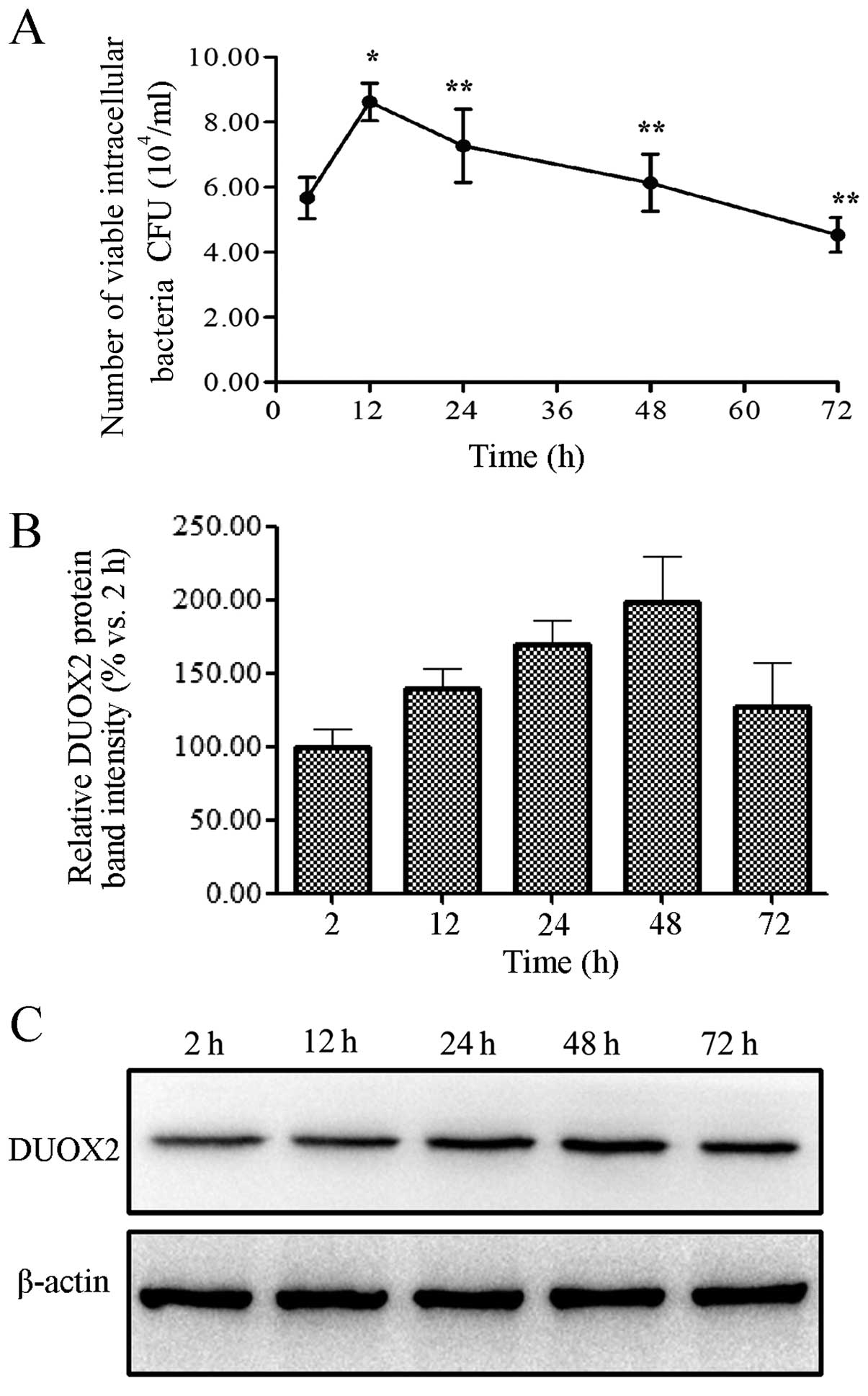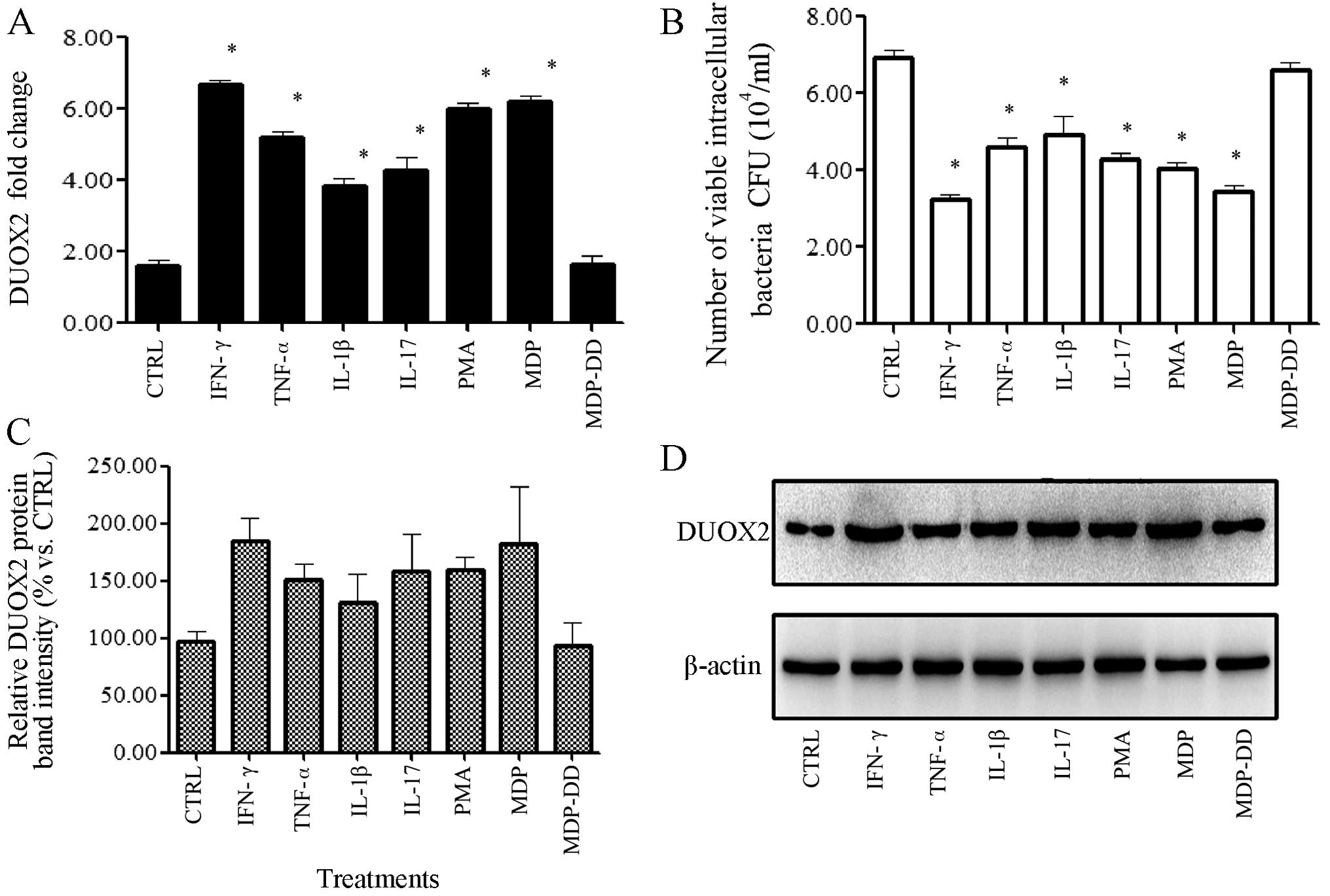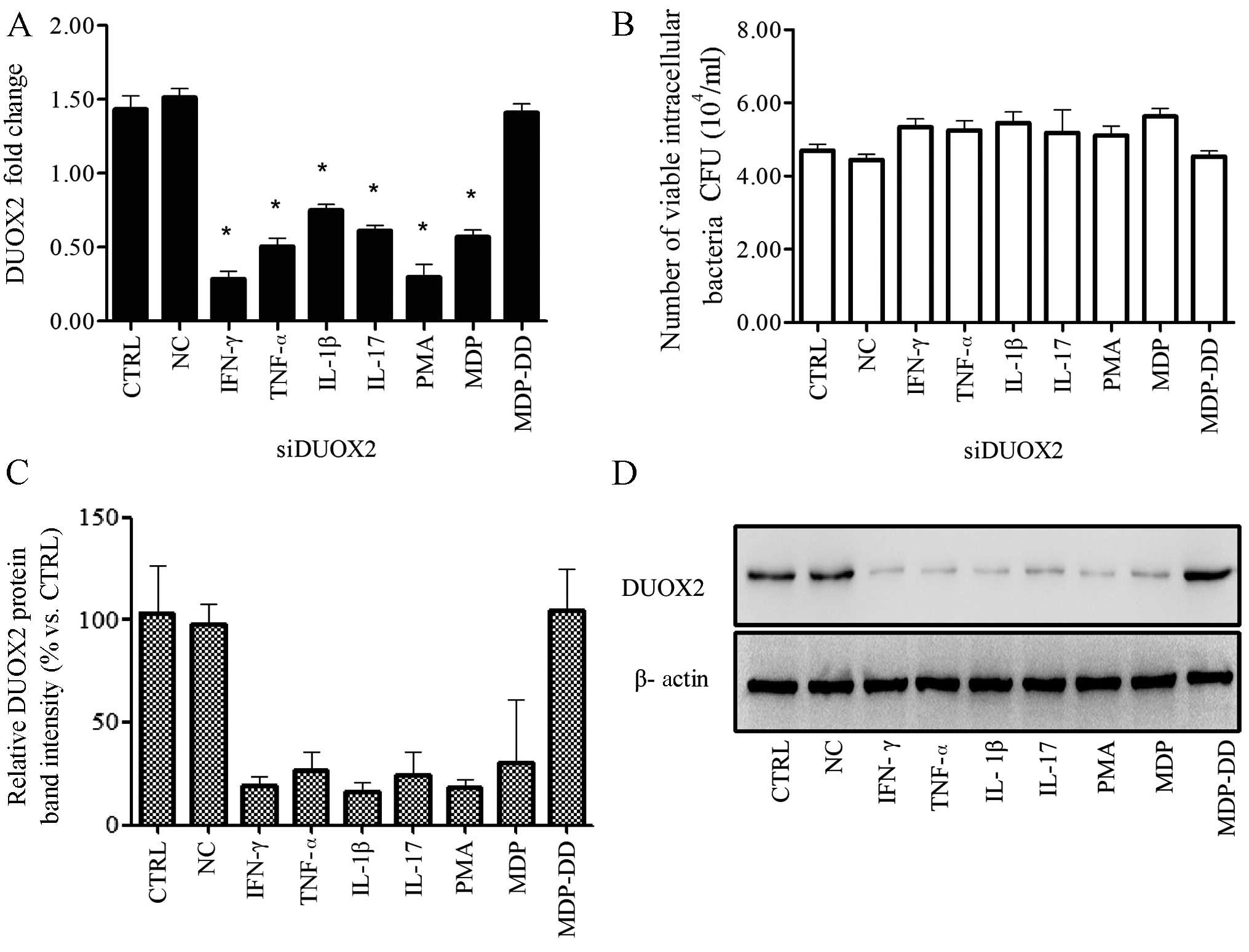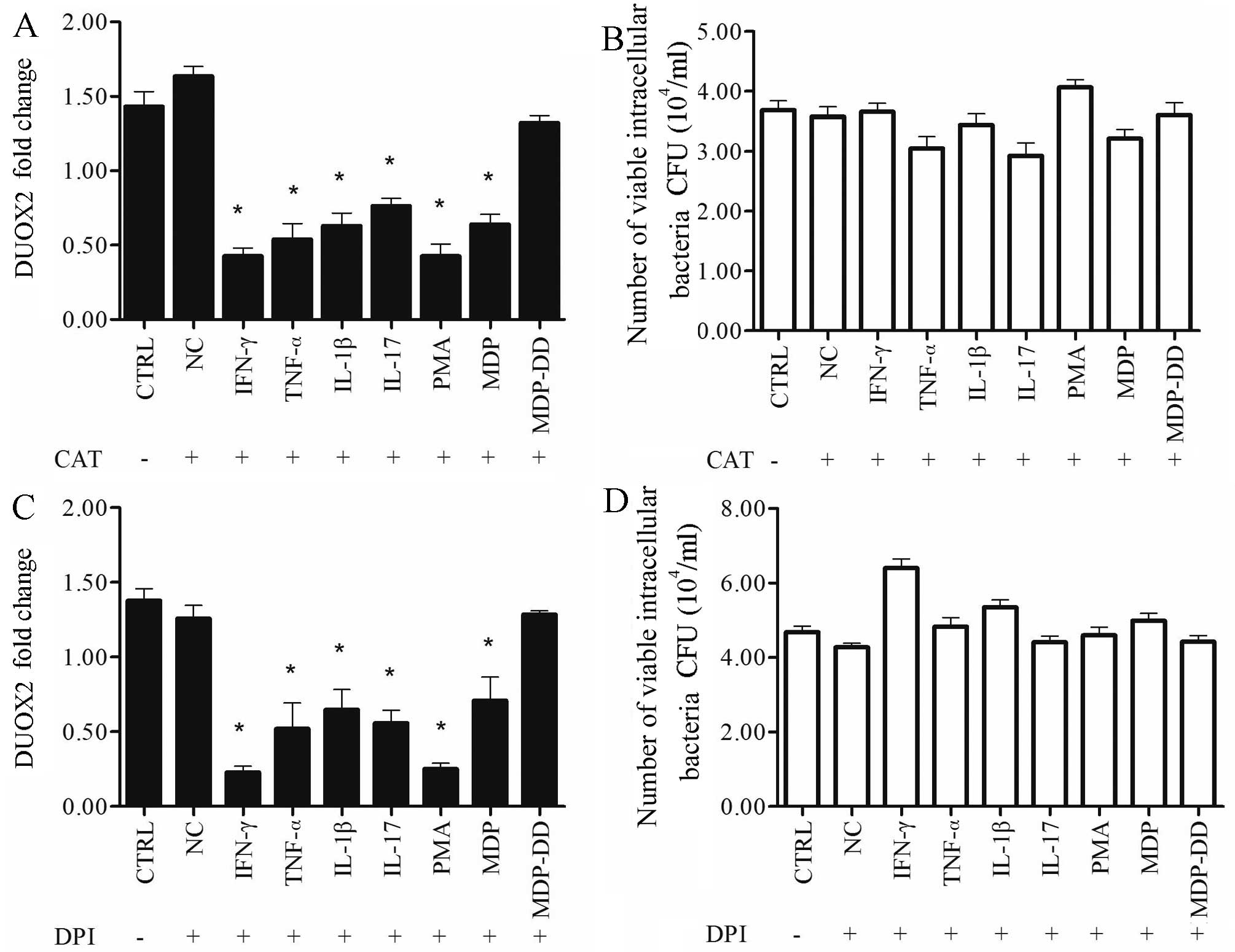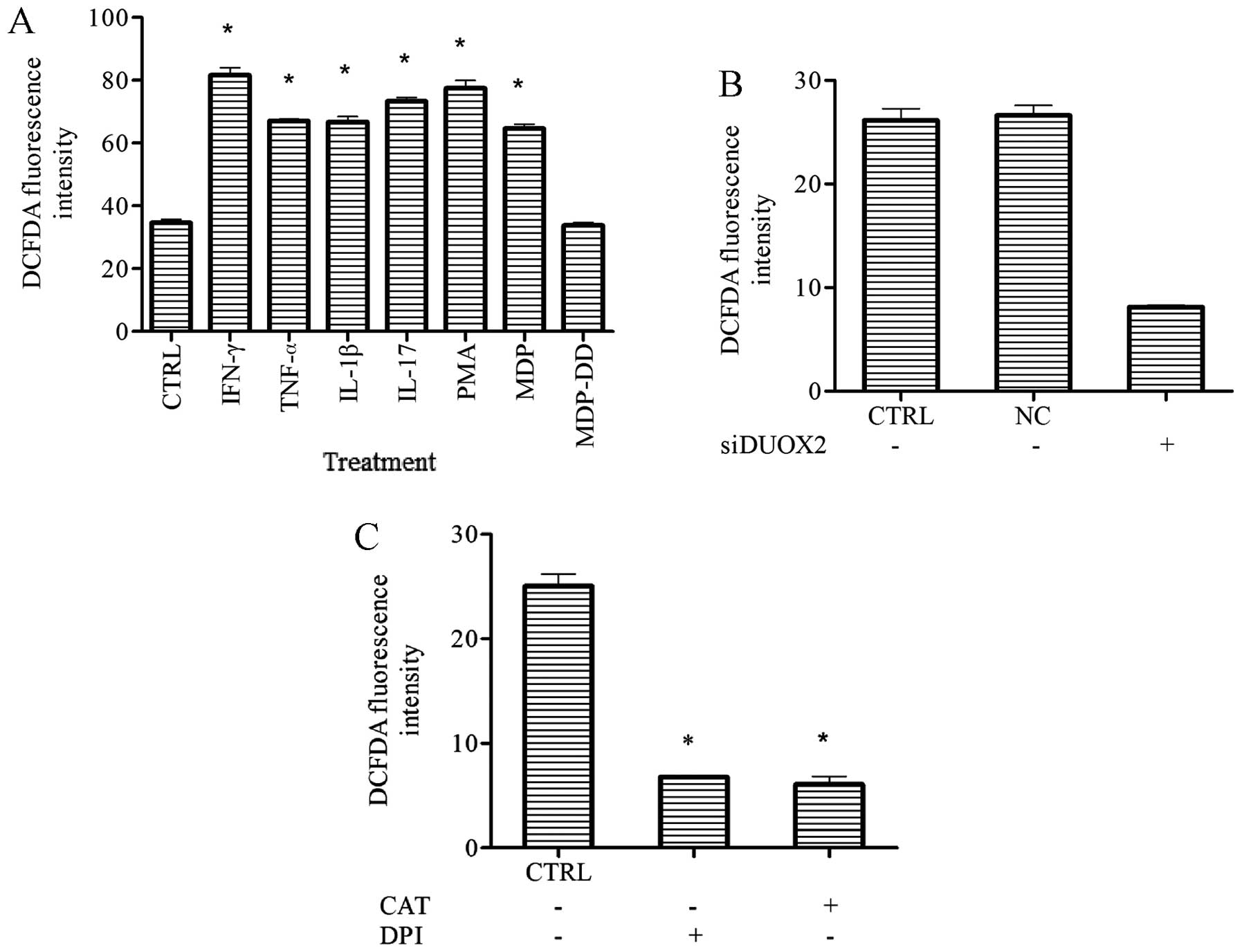|
1
|
Meca G, Sospedra I, Valero MA, Mañes J,
Font G and Ruiz MJ: Antibacterial activity of the enniatin B,
produced by Fusarium tricinctum in liquid culture, and cytotoxic
effects on Caco-2 cells. Toxicol Mech Methods. 21:503–512. 2011.
View Article : Google Scholar : PubMed/NCBI
|
|
2
|
Rhim AD, Stoykova L, Glick MC and Scanlin
TF: Terminal glycosylation in cystic fibrosis (CF): Aa review
emphasizing the airway epithelial cell. Glycoconj J. 18:649–659.
2001. View Article : Google Scholar
|
|
3
|
Swords WE, Chance DL, Cohn LA, Shao J,
Apicella MA and Smith AL: Acylation of the lipooligosaccharide of
Haemophilus influenzae and colonization: an htrB mutation
diminishes the colonization of human airway epithelial cells.
Infect Immun. 70:4661–4668. 2002. View Article : Google Scholar : PubMed/NCBI
|
|
4
|
Loose M, Hudel M, Zimmer KP, Garcia E,
Hammerschmidt S, Lucas R, Chakraborty T and Pillich H: Pneumococcal
hydrogen peroxide-induced stress signaling regulates inflammatory
genes. J Infect Dis. 211:306–316. 2014. View Article : Google Scholar : PubMed/NCBI
|
|
5
|
Cortés G, Alvarez D, Saus C and Albertí S:
Role of lung epithelial cells in defense against Klebsiella
pneumoniae pneumonia. Infect Immun. 70:1075–1080. 2002. View Article : Google Scholar : PubMed/NCBI
|
|
6
|
Rosen DA, Pinkner JS, Walker JN, Elam JS,
Jones JM and Hultgren SJ: Molecular variations in Klebsiella
pneumoniae and Escherichia coli FimH affect function and
pathogenesis in the urinary tract. Infect Immun. 76:3346–3356.
2008. View Article : Google Scholar : PubMed/NCBI
|
|
7
|
Zgair AK and Al-Adressi AM:
Stenotrophomonas maltophilia fimbrin stimulates mouse bladder
innate immune response. Eur J Clin Microbiol Infect Dis.
32:139–146. 2013. View Article : Google Scholar
|
|
8
|
Michelet C, Avril JL, Cartier F and Berche
P: Inhibition of intracellular growth of Listeria monocytogenes by
antibiotics. Antimicrob Agents Chemother. 38:438–446. 1994.
View Article : Google Scholar : PubMed/NCBI
|
|
9
|
Nakagawa I, Amano A, Mizushima N, Yamamoto
A, Yamaguchi H, Kamimoto T, Nara A, Funao J, Nakata M, Tsuda K, et
al: Autophagy defends cells against invading group A Streptococcus.
Science. 306:1037–1040. 2004. View Article : Google Scholar : PubMed/NCBI
|
|
10
|
Grasberger H, El-Zaatari M, Dang DT and
Merchant JL: Dual oxidases control release of hydrogen peroxide by
the gastric epithelium to prevent Helicobacter felis infection and
inflammation in mice. Gastroenterology. 145:1045–1054. 2013.
View Article : Google Scholar : PubMed/NCBI
|
|
11
|
Rada B and Leto TL: Oxidative innate
immune defenses by Nox/Duox family NADPH oxidases. Contrib
Microbiol. 15:164–187. 2008. View Article : Google Scholar : PubMed/NCBI
|
|
12
|
Enyedi B and Niethammer P:
H2O2: a chemoattractant? Methods Enzymol.
528:237–255. 2013. View Article : Google Scholar
|
|
13
|
Geiszt M and Leto TL: The Nox family of
NAD(P)H oxidases: host defense and beyond. J Biol Chem.
279:51715–51718. 2004. View Article : Google Scholar : PubMed/NCBI
|
|
14
|
Lees MS, H Nagaraj S, Piedrafita DM, Kotze
AC and Ingham AB: Molecular cloning and characterisation of ovine
dual oxidase 2. Gene. 500:40–46. 2012. View Article : Google Scholar : PubMed/NCBI
|
|
15
|
Rigutto S, Hoste C, Grasberger H,
Milenkovic M, Communi D, Dumont JE, Corvilain B, Miot F and De
Deken X: Activation of dual oxidases Duox1 and Duox2: differential
regulation mediated by camp-dependent protein kinase and protein
kinase C-dependent phosphorylation. J Biol Chem. 284:6725–6734.
2009. View Article : Google Scholar : PubMed/NCBI
|
|
16
|
Kim HJ, Kim CH, Ryu JH, Kim MJ, Park CY,
Lee JM, Holtzman MJ and Yoon JH: Reactive oxygen species induce
antiviral innate immune response through IFN-λ regulation in human
nasal epithelial cells. Am J Respir Cell Mol Biol. 49:855–865.
2013. View Article : Google Scholar : PubMed/NCBI
|
|
17
|
Fink K, Martin L, Mukawera E, Chartier S,
De Deken X, Brochiero E, Miot F and Grandvaux N: IFNβ/TNFα
synergism induces a non-canonical STAT2/IRF9-dependent pathway
triggering a novel DUOX2 NADPH oxidase-mediated airway antiviral
response. Cell Res. 23:673–690. 2013. View Article : Google Scholar : PubMed/NCBI
|
|
18
|
Strengert M, Jennings R, Davanture S,
Hayes P, Gabriel G and Knaus UG: Mucosal reactive oxygen species
are required for antiviral response: Rrole of Duox in influenza a
virus infection. Antioxid Redox Signal. 20:2695–2709. 2014.
View Article : Google Scholar
|
|
19
|
Lipinski S, Till A, Sina C, Arlt A,
Grasberger H, Schreiber S and Rosenstiel P: DUOX2-derived reactive
oxygen species are effectors of NOD2-mediated antibacterial
responses. J Cell Sci. 122:3522–3530. 2009. View Article : Google Scholar : PubMed/NCBI
|
|
20
|
Ronald A and Ludwig E: Urinary tract
infections in adults with diabetes. Int J Antimicrob Agents.
17:287–292. 2001. View Article : Google Scholar : PubMed/NCBI
|
|
21
|
Hansen DS, Gottschau A and Kolmos HJ:
Epidemiology of Klebsiella bacteraemia: Aa case control study using
Escherichia coli bacteraemia as control. J Hosp Infect. 38:119–132.
1998. View Article : Google Scholar : PubMed/NCBI
|
|
22
|
Donkó A, Ruisanchez E, Orient A, Enyedi B,
Kapui R, Péterfi Z, de Deken X, Benyó Z and Geiszt M: Urothelial
cells produce hydrogen peroxide through the activation of Duox1.
Free Radic Biol Med. 49:2040–2048. 2010. View Article : Google Scholar : PubMed/NCBI
|
|
23
|
El Hassani RA, Benfares N, Caillou B,
Talbot M, Sabourin JC, Belotte V, Morand S, Gnidehou S, Agnandji D,
Ohayon R, et al: Dual oxidase2 is expressed all along the digestive
tract. Am J Physiol Gastrointest Liver Physiol. 288:G933–G942.
2005. View Article : Google Scholar
|
|
24
|
Ha EM, Oh CT, Bae YS and Lee WJ: A direct
role for dual oxidase in Drosophila gut immunity. Science.
310:847–850. 2005. View Article : Google Scholar : PubMed/NCBI
|
|
25
|
Flores MV, Crawford KC, Pullin LM, Hall
CJ, Crosier KE and Crosier PS: Dual oxidase in the intestinal
epithelium of zebrafish larvae has anti-bacterial properties.
Biochem Biophys Res Commun. 400:164–168. 2010. View Article : Google Scholar : PubMed/NCBI
|
|
26
|
Harper RW, Xu C, Eiserich JP, Chen Y, Kao
CY, Thai P, Setiadi H and Wu R: Differential regulation of dual
NADPH oxidases/peroxidases, Duox1 and Duox2, by Th1 and Th2
cytokines in respiratory tract epithelium. FEBS Lett.
579:4911–4917. 2005. View Article : Google Scholar : PubMed/NCBI
|
|
27
|
Geiszt M, Lekstrom K, Brenner S, Hewitt
SM, Dana R, Malech HL and Leto TL: NAD(P)H oxidase 1, a product of
differentiated colon epithelial cells, can partially replace
glycoprotein 91phox in the regulated production of superoxide by
phagocytes. J Immunol. 171:299–306. 2003. View Article : Google Scholar : PubMed/NCBI
|
|
28
|
Geiszt M, Lekstrom K, Witta J and Leto TL:
Proteins homologous to p47phox and p67phox support superoxide
production by NAD(P)H oxidase 1 in colon epithelial cells. J Biol
Chem. 278:20006–20012. 2003. View Article : Google Scholar : PubMed/NCBI
|
|
29
|
O’Quinn DB, Palmer MT, Lee YK and Weaver
CT: Emergence of the Th17 pathway and its role in host defense. Adv
Immunol. 99:115–163. 2008. View Article : Google Scholar
|
|
30
|
Miljkovic D and Trajkovic V: Inducible
nitric oxide synthase activation by interleukin-17. Cytokine Growth
Factor Rev. 15:21–32. 2004. View Article : Google Scholar : PubMed/NCBI
|
|
31
|
Trajkovic V, Stosic-Grujicic S, Samardzic
T, Markovic M, Miljkovic D, Ramic Z and Mostarica Stojkovic M:
Interleukin-17 stimulates inducible nitric oxide synthase
activation in rodent astrocytes. J Neuroimmunol. 119:183–191. 2001.
View Article : Google Scholar : PubMed/NCBI
|
|
32
|
Willems MM, Zom GG, Meeuwenoord N,
Ossendorp FA, Overkleeft HS, van der Marel GA, Codée JD and
Filippov DV: Design, automated synthesis and immunological
evaluation of NOD2-ligand-antigen conjugates. Beilstein J Org Chem.
10:1445–1453. 2014. View Article : Google Scholar : PubMed/NCBI
|
|
33
|
Kim HJ, Kim CH, Ryu JH, Joo JH, Lee SN,
Kim MJ, Lee JG, Bae YS and Yoon JH: Crosstalk between
platelet-derived growth factor-induced Nox4 activation and MUC8
gene overexpression in human airway epithelial cells. Free Radic
Biol Med. 50:1039–1052. 2011. View Article : Google Scholar : PubMed/NCBI
|
|
34
|
van der Vliet A: NADPH oxidases in lung
biology and pathology: hHost defense enzymes, and more. Free Radic
Biol Med. 44:938–955. 2008. View Article : Google Scholar : PubMed/NCBI
|
|
35
|
Arnoult D, Carneiro L, Tattoli I and
Girardin SE: The role of mitochondria in cellular defense against
microbial infection. Semin Immunol. 21:223–232. 2009. View Article : Google Scholar : PubMed/NCBI
|
|
36
|
Gao XP, Standiford TJ, Rahman A, Newstead
M, Holland SM, Dinauer MC, Liu QH and Malik AB: Role of NADPH
oxidase in the mechanism of lung neutrophil sequestration and
microvessel injury induced by Gram-negative sepsis: Studies in
p47phox−/− and gp91phox−/− mice. J Immunol.
168:3974–3982. 2002. View Article : Google Scholar : PubMed/NCBI
|
|
37
|
Koarai A, Sugiura H, Yanagisawa S,
Ichikawa T, Minakata Y, Matsunaga K, Hirano T, Akamatsu K and
Ichinose M: Oxidative stress enhances toll-like receptor 3 response
to double-stranded RNA in airway epithelial cells. Am J Respir Cell
Mol Biol. 42:651–660. 2010. View Article : Google Scholar :
|
|
38
|
Zmijewski JW, Lorne E, Zhao X, Tsuruta Y,
Sha Y, Liu G and Abraham E: Antiinflammatory effects of hydrogen
peroxide in neutrophil activation and acute lung injury. Am J
Respir Crit Care Med. 179:694–704. 2009. View Article : Google Scholar : PubMed/NCBI
|
|
39
|
Hou Y, An J, Hu XR, Sun BB, Lin J, Xu D,
Wang T and Wen FQ: Ghrelin inhibits interleukin-8 production
induced by hydrogen peroxide in A549 cells via NF-kappaB pathway.
Int Immunopharmacol. 9:120–126. 2009. View Article : Google Scholar
|
|
40
|
Kim JY, Omori E, Matsumoto K, Núñez G and
Ninomiya-Tsuji J: TAK1 is a central mediator of NOD2 signaling in
epidermal cells. J Biol Chem. 283:137–144. 2008. View Article : Google Scholar
|
|
41
|
Forteza R, Salathe M, Miot F, Forteza R
and Conner GE: Regulated hydrogen peroxide production by Duox in
human airway epithelial cells. Am J Respir Cell Mol Biol.
32:462–469. 2005. View Article : Google Scholar : PubMed/NCBI
|
|
42
|
Gattas MV, Forteza R, Fragoso MA, Fregien
N, Salas P, Salathe M and Conner GE: Oxidative epithelial host
defense is regulated by infectious and inflammatory stimuli. Free
Radic Biol Med. 47:1450–1458. 2009. View Article : Google Scholar : PubMed/NCBI
|
|
43
|
Geiszt M, Witta J, Baffi J, Lekstrom K and
Leto TL: Dual oxidases represent novel hydrogen peroxide sources
supporting mucosal surface host defense. FASEB J. 17:1502–1504.
2003.PubMed/NCBI
|



